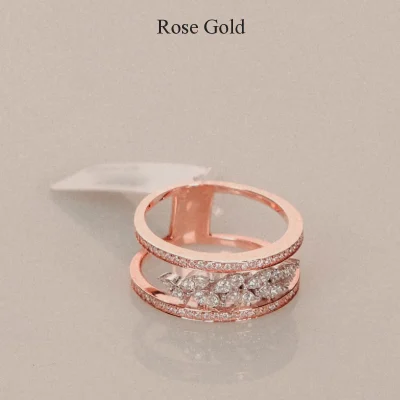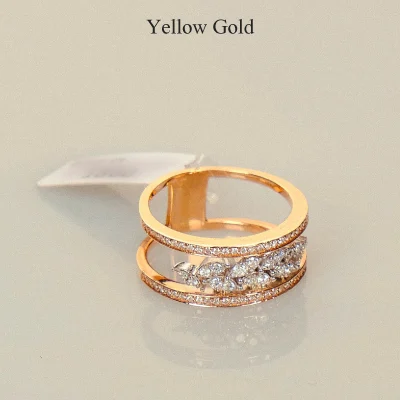Rose gold is currently very trendy and we all are fond of it. This beautiful
pink hue is being embraced in everything from smartphones and smartwatches to
makeup palettes. And here, the popular debate starts on rose gold vs yellow
gold! Both are equally valuable and desirable.
The popularity of rose gold has led to nearly all Clean Origin products being
available in this color. However, new trends naturally lead to new inquiries.
Therefore, we are here to address some of the commonly asked questions about
rose gold vs yellow gold and white gold.
What is Rose Gold?

You can't call rose gold the purest form of gold. Rather, it is a
combination of yellow gold and other metals or an alloy. Yellow gold and
copper combine to form rose gold. The well-known pink color that
complements all skin tones is attributed to the copper.
When it comes to men's wedding bands and engagement rings, the gorgeous
pink gold is quickly taking over. Rose gold engagement rings are currently
available online and in large jewelry retailers.
It is thought that jeweler Carl Faberge included rose gold into his
Faberge Eggs in Russia during the 19th century, marking the beginning of
the color's popularity. Rose gold is sometimes referred to be Russian gold
for this reason. It’s appeal has only increased since then.
What is Yellow Gold?

The rich, deep tone of yellow gold is frequently utilized in jewelry
creation. Yellow gold is used in the majority of wedding bands, engagement
rings, and other jewelry designs.
The ratio of gold to silver or copper in the alloy is referred to as the
composition of yellow gold. A piece of 24-karat gold has a purity rating
of 99.9%. It is a relatively soft metal, though, so you're more likely to
encounter jewelry fashioned of the harder 18-karat variety. A 14-karat
piece of gold is 58.3% gold, whilst an 18-karat piece shows a purity value
of 75%.
Because yellow gold is flexible and easy for jewelers to handle or resize,
it is a popular choice. It goes well with both modern and classic styles,
is easy to clean, and is primarily hypoallergenic. Warm tones bring out
the best in low-grade diamonds, accentuate olive and deeper complexion
tones, and provide the purest gold color.
Key Differences Between Rose Gold and Yellow Gold
Composition: Rose Gold vs Yellow Gold
When comparing rose gold vs yellow gold, the main difference lies in their
composition. Yellow gold is made by mixing pure gold with metals like copper
and zinc, while rose gold is created by adding more copper, giving it that
distinctive pinkish hue.
Color: Rose Gold vs Yellow Gold
Rose gold has a soft, romantic pink tone, while yellow gold boasts a classic
warm, golden hue. The choice between rose gold or yellow gold often depends on
personal style and aesthetic preference.
Durability and Strength
In the debate of rose gold or yellow gold, rose gold tends to be more durable
due to its higher copper content, making it less prone to scratches compared
to yellow gold.
Skin Tone Compatibility
When it comes to rose gold vs yellow gold skin tone compatibility, rose gold
flatters cool and neutral skin tones, while yellow gold complements warmer and
olive skin tones beautifully. Yet, it’s your own preference which gold to wear
or combine both!
Care and Maintenance
Both metals are relatively easy to maintain, but rose gold requires occasional
polishing to prevent tarnishing due to copper. Yellow gold, being softer,
should be handled with care to avoid scratches.
Popular Uses in Jewelry
Both rose gold and yellow gold are commonly used in rings, necklaces,
bracelets, and earrings. Yellow gold is a timeless choice for engagement
rings, while rose gold is popular in vintage and modern designs alike.
Skin Tone Considerations
It's crucial to take your skin tone into account while deciding between rose
gold and yellow gold jewelry. A timeless choice, gold brings out the best in
yellow, red, or olive undertones on warm complexion tones. It enhances the
depth and beauty of your entire appearance.
A combination of copper and gold rose gold has a pinkish tone that complements
both warm and cool complexion tones. It creates harmony for tones with pink or
blue undertones by softening the look of cool tones.
Both metals improve the appearance of pale skin: rose gold creates a subtle
contrast, while gold draws attention to warm undertones. Both have stunning
dark skin tones, with rose gold adding a chic blush and gold offering
elegance. In the end, both choices can provide gorgeous looks that accentuate
your inherent beauty.
So, instead of getting into the yellow gold vs rose gold contention, just wear
whichever metal you choose; they'll complement each other.
Conclusion
In a nutshell, talking about rose gold vs yellow gold and choosing between
the two ultimately comes down to personal preference and how each metal
complements your skin tone. Rose gold’s romantic pink hue is versatile,
flattering both warm and cool tones, while yellow gold’s classic warm color
enhances the richness of warm skin tones. Each metal has its unique charm
and durability, making them excellent choices for various jewelry pieces.
Whether you prefer the trendy allure of rose gold or the timeless elegance
of yellow gold, both can elevate your style and highlight your natural
beauty.
Embrace your choice and enjoy the beauty of your selected metal!
Rose gold is currently very trendy and we all are fond of it. This beautiful
pink hue is being embraced in everything from smartphones and smartwatches to
makeup palettes. And here, the popular debate starts on rose gold vs yellow
gold! Both are equally valuable and desirable.
The popularity of rose gold has led to nearly all Clean Origin products being
available in this color. However, new trends naturally lead to new inquiries.
Therefore, we are here to address some of the commonly asked questions about
rose gold vs yellow gold and white gold.
What is Rose Gold?

You can't call rose gold the purest form of gold. Rather, it is a
combination of yellow gold and other metals or an alloy. Yellow gold and
copper combine to form rose gold. The well-known pink color that
complements all skin tones is attributed to the copper.
When it comes to men's wedding bands and engagement rings, the gorgeous
pink gold is quickly taking over. Rose gold engagement rings are currently
available online and in large jewelry retailers.
It is thought that jeweler Carl Faberge included rose gold into his
Faberge Eggs in Russia during the 19th century, marking the beginning of
the color's popularity. Rose gold is sometimes referred to be Russian gold
for this reason. It’s appeal has only increased since then.
What is Yellow Gold?

The rich, deep tone of yellow gold is frequently utilized in jewelry
creation. Yellow gold is used in the majority of wedding bands, engagement
rings, and other jewelry designs.
The ratio of gold to silver or copper in the alloy is referred to as the
composition of yellow gold. A piece of 24-karat gold has a purity rating
of 99.9%. It is a relatively soft metal, though, so you're more likely to
encounter jewelry fashioned of the harder 18-karat variety. A 14-karat
piece of gold is 58.3% gold, whilst an 18-karat piece shows a purity value
of 75%.
Because yellow gold is flexible and easy for jewelers to handle or resize,
it is a popular choice. It goes well with both modern and classic styles,
is easy to clean, and is primarily hypoallergenic. Warm tones bring out
the best in low-grade diamonds, accentuate olive and deeper complexion
tones, and provide the purest gold color.
Key Differences Between Rose Gold and Yellow Gold
Composition: Rose Gold vs Yellow Gold
When comparing rose gold vs yellow gold, the main difference lies in their
composition. Yellow gold is made by mixing pure gold with metals like copper
and zinc, while rose gold is created by adding more copper, giving it that
distinctive pinkish hue.
Color: Rose Gold vs Yellow Gold
Rose gold has a soft, romantic pink tone, while yellow gold boasts a classic
warm, golden hue. The choice between rose gold or yellow gold often depends on
personal style and aesthetic preference.
Durability and Strength
In the debate of rose gold or yellow gold, rose gold tends to be more durable
due to its higher copper content, making it less prone to scratches compared
to yellow gold.
Skin Tone Compatibility
When it comes to rose gold vs yellow gold skin tone compatibility, rose gold
flatters cool and neutral skin tones, while yellow gold complements warmer and
olive skin tones beautifully. Yet, it’s your own preference which gold to wear
or combine both!
Care and Maintenance
Both metals are relatively easy to maintain, but rose gold requires occasional
polishing to prevent tarnishing due to copper. Yellow gold, being softer,
should be handled with care to avoid scratches.
Popular Uses in Jewelry
Both rose gold and yellow gold are commonly used in rings, necklaces,
bracelets, and earrings. Yellow gold is a timeless choice for engagement
rings, while rose gold is popular in vintage and modern designs alike.
Skin Tone Considerations
It's crucial to take your skin tone into account while deciding between rose
gold and yellow gold jewelry. A timeless choice, gold brings out the best in
yellow, red, or olive undertones on warm complexion tones. It enhances the
depth and beauty of your entire appearance.
A combination of copper and gold rose gold has a pinkish tone that complements
both warm and cool complexion tones. It creates harmony for tones with pink or
blue undertones by softening the look of cool tones.
Both metals improve the appearance of pale skin: rose gold creates a subtle
contrast, while gold draws attention to warm undertones. Both have stunning
dark skin tones, with rose gold adding a chic blush and gold offering
elegance. In the end, both choices can provide gorgeous looks that accentuate
your inherent beauty.
So, instead of getting into the yellow gold vs rose gold contention, just wear
whichever metal you choose; they'll complement each other.
Conclusion
In a nutshell, talking about rose gold vs yellow gold and choosing between
the two ultimately comes down to personal preference and how each metal
complements your skin tone. Rose gold’s romantic pink hue is versatile,
flattering both warm and cool tones, while yellow gold’s classic warm color
enhances the richness of warm skin tones. Each metal has its unique charm
and durability, making them excellent choices for various jewelry pieces.
Whether you prefer the trendy allure of rose gold or the timeless elegance
of yellow gold, both can elevate your style and highlight your natural
beauty.
Embrace your choice and enjoy the beauty of your selected metal!


